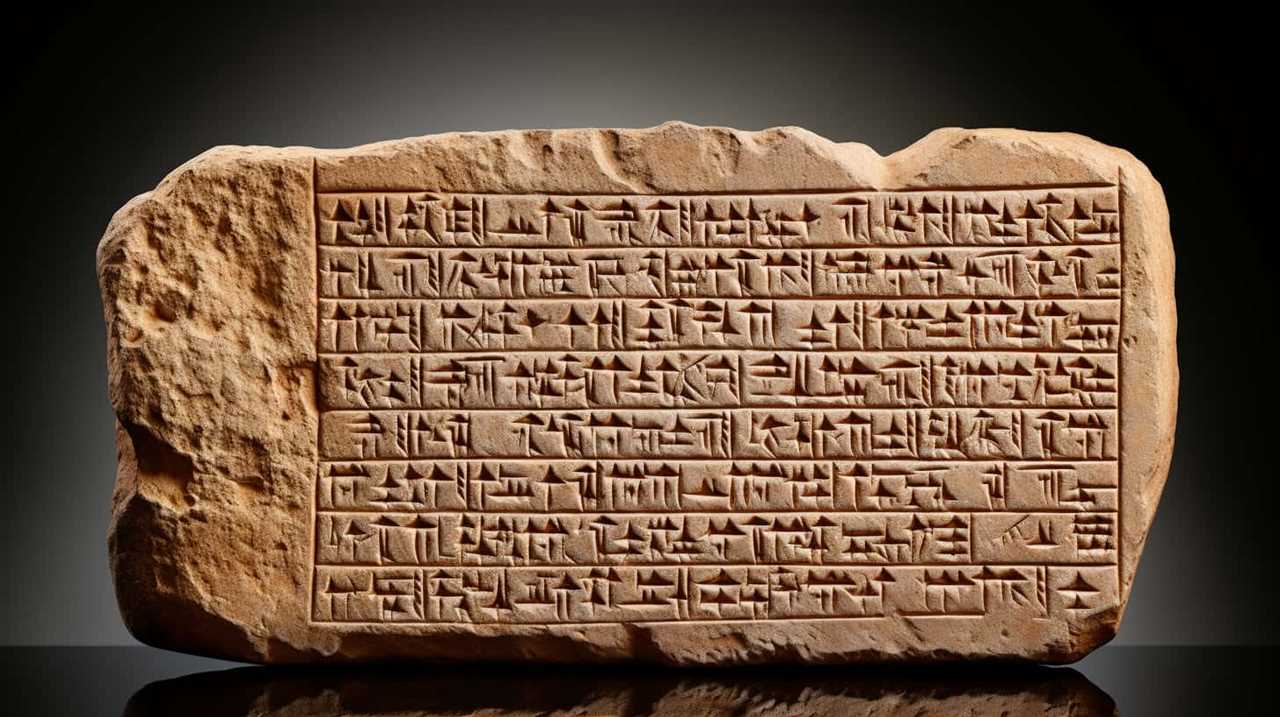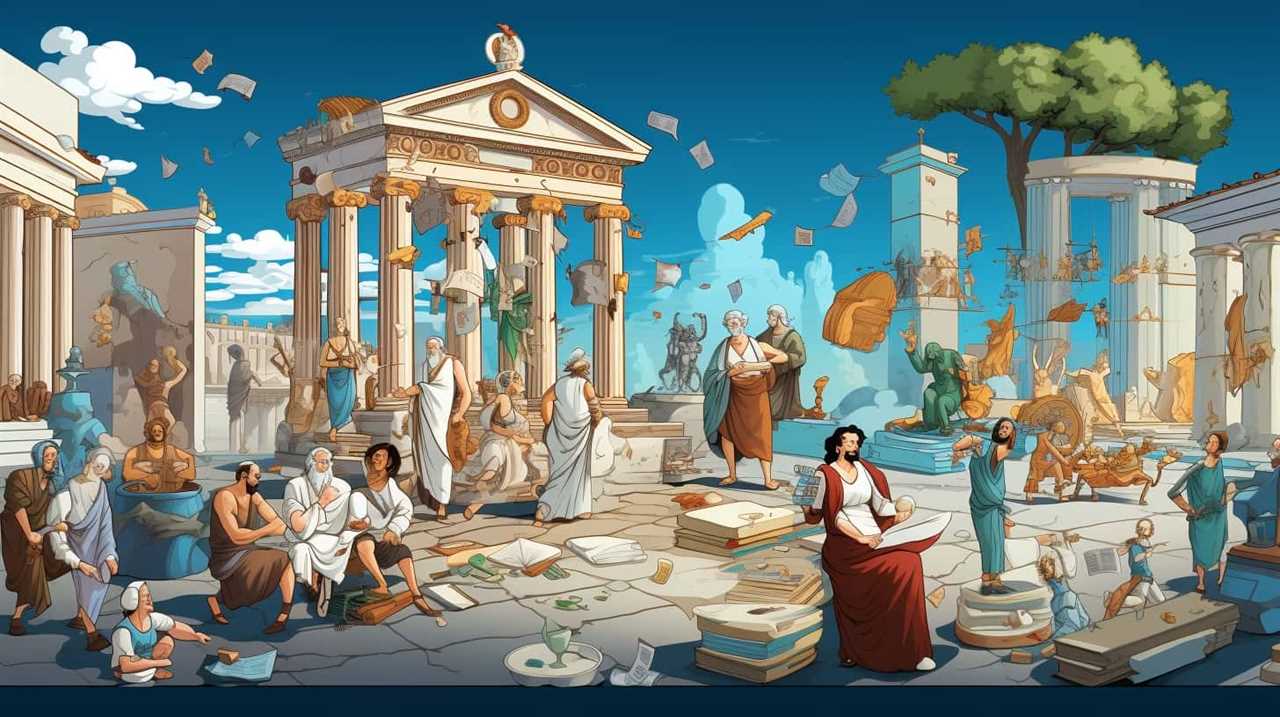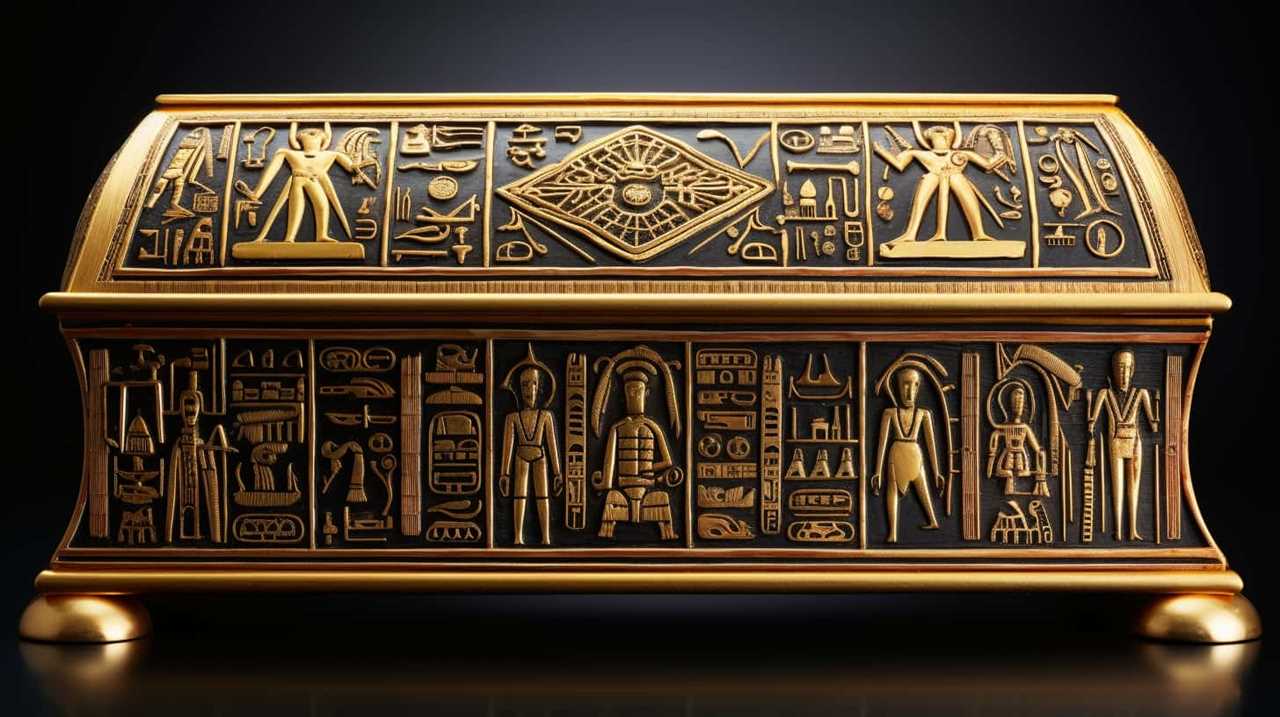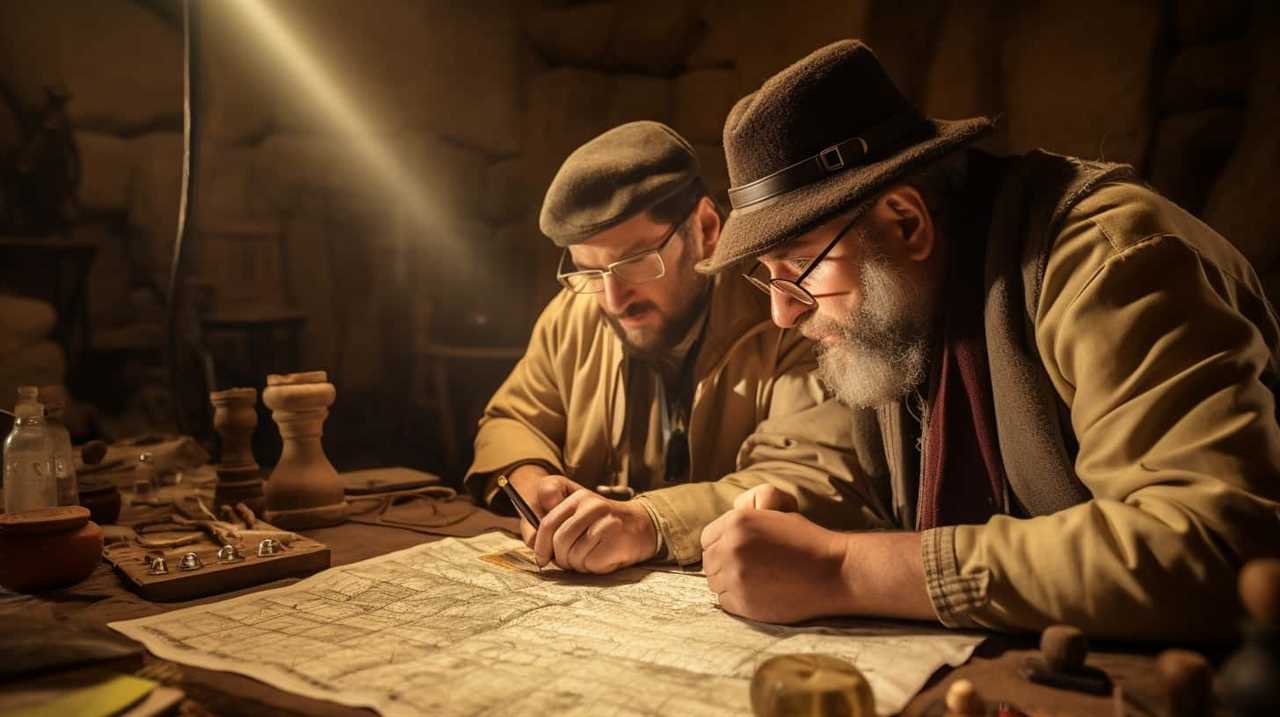Welcome to ‘Deciphering Egyptian Hieroglyphics: 12 Classic Sayings Unveiled.’
Have you ever wondered what messages lay hidden within the intricate symbols of ancient Egypt? In this captivating journey, we will embark on a quest to unravel the secrets of 12 timeless sayings etched in hieroglyphics.
Prepare to unlock the wisdom of the Pharaohs and gain a profound understanding of their culture and beliefs. Through meticulous analysis and expert guidance, we will delve into the profound meanings behind these enigmatic hieroglyphic inscriptions.
From the mysteries of the afterlife to the principles of love and success, each saying holds a treasure trove of knowledge waiting to be revealed.

So, join us as we embark on this enlightening adventure and master the art of deciphering Egyptian hieroglyphics.
Key Takeaways
- Egyptian hieroglyphics were pictorial symbols with multiple layers of meaning.
- Understanding the cultural context is crucial in deciphering the meaning of hieroglyphics.
- Hieroglyphics were considered sacred and used in religious and ceremonial contexts.
- The symbols were believed to hold divine power and connect the earthly realm with the divine realm.
The Meaning of Life in Hieroglyphics
We have uncovered the true essence of life through the deciphering of hieroglyphics. The ancient Egyptians believed that life had a deeper meaning, and they sought to understand the purpose of existence. Hieroglyphics provide us with unique insights into their philosophical and spiritual beliefs.
One of the key concepts in understanding the meaning of existence in ancient Egypt is the idea of Ma’at. Ma’at represents the fundamental principles of truth, justice, and harmony that governed the universe. It was believed that living in accordance with Ma’at would bring balance to one’s life and ensure a prosperous afterlife.
Another important aspect of the meaning of life in hieroglyphics is the concept of the Ba and the Ka. The Ba was the individual’s personality or soul, while the Ka represented the life force or vital essence. The Egyptians believed that the Ba and the Ka had to be reunited after death for eternal life to be achieved.
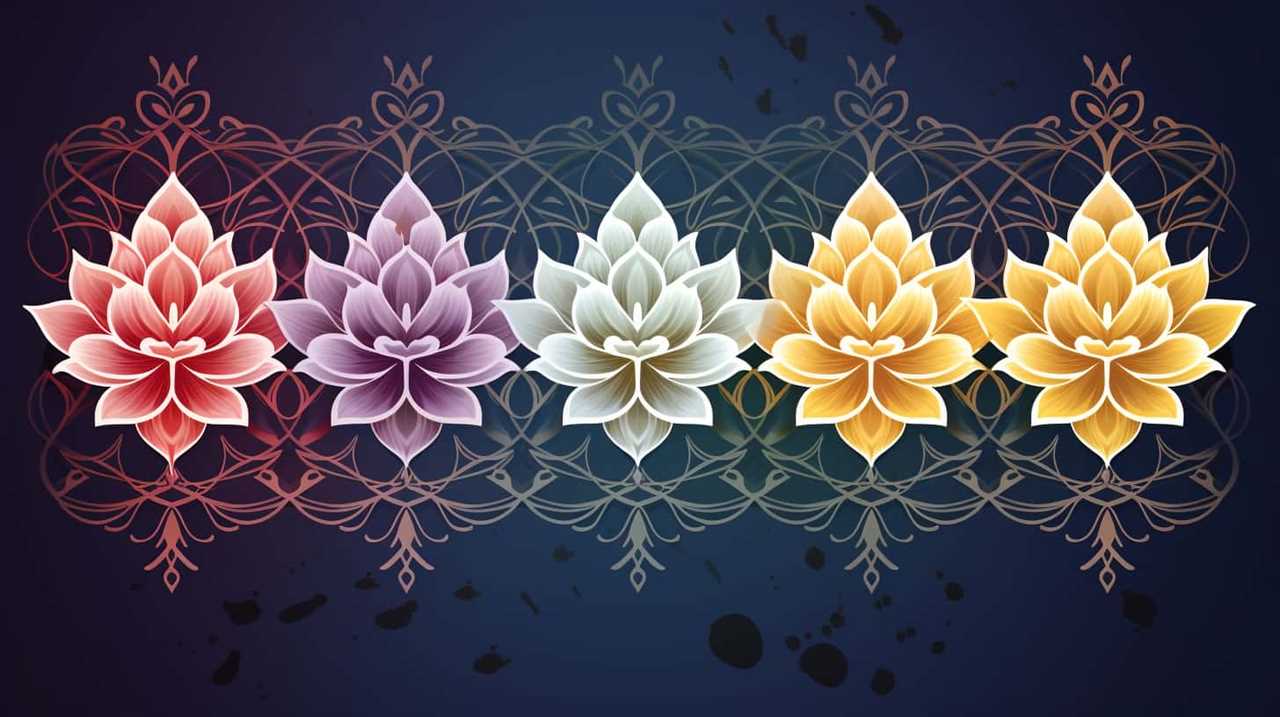
As we delve further into the study of hieroglyphics, we’ll discover how love and relationships played a significant role in ancient Egypt. The Egyptians believed in the power of love and its ability to bring fulfillment and happiness. Love was seen as a divine force that connected individuals and brought them closer to the gods.
Let’s now explore the fascinating world of love and relationships in ancient Egypt.
Love and Relationships in Ancient Egypt
Love and relationships held great significance in ancient Egyptian society. One of the key aspects was the institution of marriage, which emphasized fidelity and the creation of a stable family unit.
Amulets also played a crucial role in expressing love, as they were believed to possess protective powers and symbolized the bond between individuals.

Additionally, the pharaohs themselves played an essential role in the realm of love and relationships, as they were seen as divine figures who set an example for the rest of society.
Marriage and Fidelity
Marriage and fidelity played significant roles in the social fabric of ancient Egyptian society, highlighting the importance of commitment and loyalty.
In ancient Egypt, marriage was a sacred institution that was meant to establish a stable and harmonious union between a man and a woman. Infidelity was seen as a grave transgression with severe consequences. Adultery wasn’t only a betrayal of trust but also a violation of societal norms.
The consequences of infidelity could range from public humiliation to divorce, and in some cases, even death. Ancient Egyptians had strict marriage customs that governed the behavior of married couples. These customs were designed to ensure the prosperity and continuity of the family unit.

Symbolism of Amulets
Highlighting the significance of commitment and loyalty in ancient Egyptian society, amulets played a symbolic role in expressing love and fostering relationships. These small, wearable objects were believed to possess magical powers that could protect and enhance the wearer’s love life.
Here are four examples of amulets that were commonly associated with love and relationships in ancient Egypt:
- The Heart Amulet: Shaped like a heart, this amulet symbolized love and affection. It was believed to bring good fortune in matters of the heart and strengthen the bond between couples.
- The Knot Amulet: Depicting a knot, this amulet represented eternal love and unity. It was often given as a gift during weddings or engagements, symbolizing the unbreakable bond between two individuals.
- The Eye of Horus Amulet: This amulet, shaped like the eye of the falcon-headed god Horus, was believed to protect against evil and ensure fidelity in relationships. It was worn by both men and women to safeguard their love.
- The Scarab Amulet: Resembling a dung beetle, the scarab amulet symbolized transformation and rebirth. In the context of love and relationships, it represented the idea of finding love again after experiencing loss or heartbreak.
These amulets not only served as decorative pieces of ancient Egyptian jewelry but also held deep symbolic meanings, reinforcing the importance of love, loyalty, and commitment in relationships.
Role of Pharaohs
In our exploration of the role of Pharaohs in love and relationships in ancient Egypt, we discovered fascinating insights into the dynamics of royal unions.

The role of Pharaohs in love and relationships was intertwined with the complex web of ancient Egyptian politics. Pharaohs weren’t only rulers, but also considered divine beings, embodying both political power and religious authority.
Their marriages were often strategic alliances, aimed at strengthening political ties and maintaining stability in the kingdom. Pharaohs had the privilege of multiple spouses, including royal consorts and foreign princesses.
These unions weren’t solely based on love, but rather on the needs of the state and the desire to secure alliances. Love and romance were secondary considerations to the duty of the Pharaoh to ensure the prosperity and security of the kingdom.
Wisdom From the Pharaohs
When we examine the hieroglyphic symbols of ancient Egypt, we find that they hold a deep and profound meaning. These symbols weren’t just mere decorations, but representations of the wisdom and knowledge of the pharaohs.

Even though thousands of years have passed, the ancient wisdom from the pharaohs still resonates with us today, offering valuable insights into the human experience.
It’s through deciphering these hieroglyphics that we can unveil the timeless wisdom of the pharaohs and gain a deeper understanding of their culture and beliefs.
Deep Meaning Behind Symbols
Through our exploration of Egyptian hieroglyphics, we’ve discovered the profound significance hidden within these ancient symbols. The Egyptians used hieroglyphics as a form of written communication, but they also imbued them with hidden messages and symbolic language. These symbols weren’t merely decorative, but rather conveyed deep meaning and wisdom from the Pharaohs.
Here are four key aspects of the deep meaning behind Egyptian hieroglyphics:
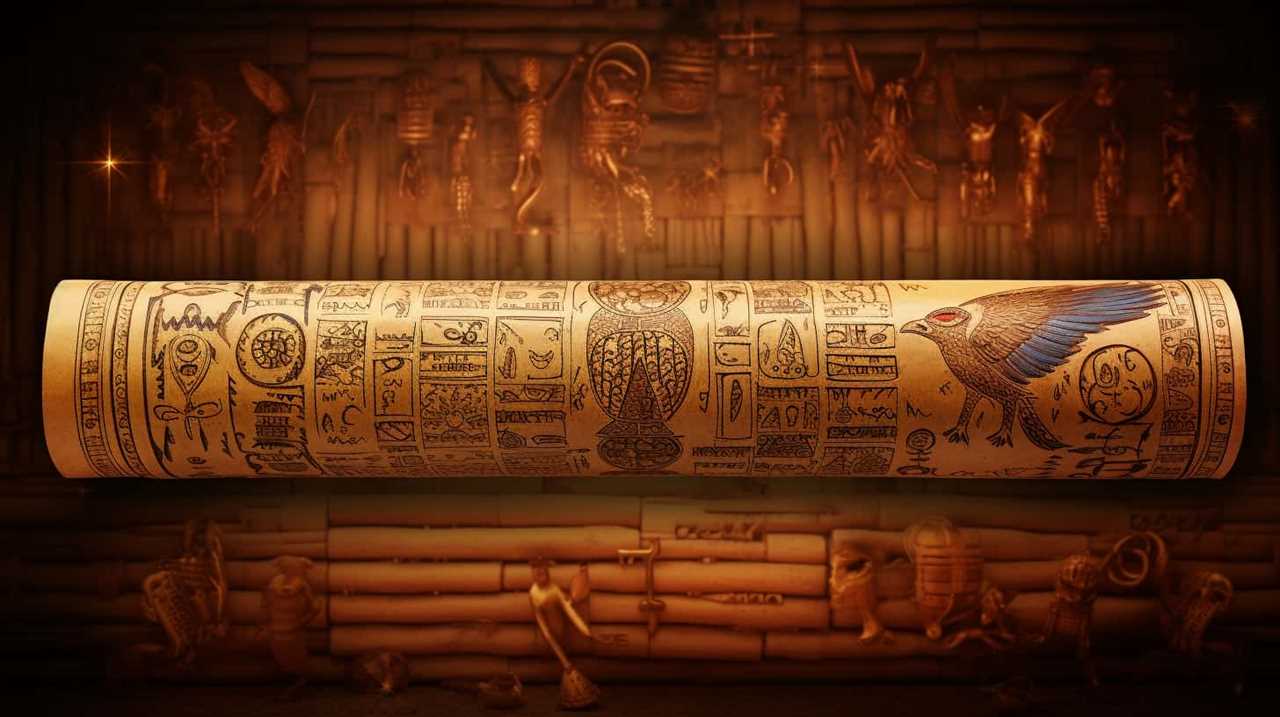
- Visual representation: Hieroglyphics were pictorial symbols that represented objects or concepts. The visual nature of these symbols allowed for a direct and intuitive understanding of the message being conveyed.
- Multiple levels of meaning: Egyptian hieroglyphics often had multiple layers of meaning, allowing for a rich and nuanced interpretation. These symbols could represent both literal and metaphorical concepts, adding depth and complexity to the message.
- Cultural context: Understanding the cultural context in which hieroglyphics were used is crucial in deciphering their meaning. The symbols were deeply rooted in Egyptian culture and religion, reflecting their beliefs, rituals, and values.
- Sacred significance: Hieroglyphics were considered sacred and were used in religious and ceremonial contexts. The symbols were believed to hold divine power and were thought to connect the earthly realm with the divine realm.
Ancient Wisdom Still Relevant
We have uncovered timeless wisdom from the Pharaohs that remains relevant today through deciphering Egyptian hieroglyphics. These ancient teachings offer valuable insights that can be applied to modern society for personal growth and development.
The wisdom imparted by the Pharaohs emphasizes the importance of self-reflection, balance, and perseverance. In a world that’s constantly changing and evolving, these principles can serve as guiding principles for navigating the complexities of life.
The Pharaohs understood the significance of introspection and self-awareness as tools for personal transformation. By embracing these ancient teachings, individuals can cultivate a deeper understanding of themselves and their place in the world.
The wisdom of the Pharaohs offers a timeless roadmap for achieving personal success and fulfillment in the present day. As we delve deeper into the secrets to success in Egyptian hieroglyphics, we’ll uncover the practical applications of these ancient teachings in our modern lives.

Secrets to Success in Egyptian Hieroglyphics
In the realm of deciphering Egyptian hieroglyphics, understanding the secrets to success is a paramount task for us. Mastering the translation of this ancient writing system requires dedication, patience, and a deep understanding of the language’s unique characteristics.
To help you on your journey to mastery, here are four essential secrets to success in Egyptian hieroglyphics:
- Study the Symbols: Egyptian hieroglyphics consist of a complex system of symbols, each representing a word, sound, or concept. Familiarize yourself with the various hieroglyphic characters and their meanings to build a solid foundation for translation.
- Learn the Grammar: Egyptian hieroglyphics have a distinct grammar structure. Understanding the rules of grammar, such as word order and verb conjugation, will greatly enhance your ability to decipher and translate texts accurately.
- Context is Key: Egyptian hieroglyphics often rely on contextual clues to convey meaning. Pay close attention to the surrounding symbols and hieroglyphs to decipher the intended message. Additionally, understanding the historical and cultural context of the text can provide valuable insights.
- Practice, Practice, Practice: Like any skill, proficiency in Egyptian hieroglyphics comes with practice. Engage in regular translation exercises, work with authentic texts, and seek opportunities to apply your knowledge. The more you practice, the more proficient you’ll become.
By following these secrets to success in Egyptian hieroglyphics, you’ll be well on your way to mastering this ancient writing system.
Now, let’s delve into the world of ancient Egyptian proverbs and maxims, where we’ll uncover the timeless wisdom contained within.

Ancient Egyptian Proverbs and Maxims
As we explore the world of ancient Egyptian proverbs and maxims, it is important to note the profound wisdom conveyed through these timeless sayings. The ancient Egyptians were known for their deep understanding of life and their ability to distill complex concepts into simple, yet powerful, phrases. These proverbs and maxims offer us a glimpse into their ancient wisdom and provide timeless advice that is still relevant today.
To showcase some of these ancient sayings, let us examine the following table:
| Proverb/Maxim | Translation |
|---|---|
| "Silence is better than idle talk." | This proverb emphasizes the importance of thinking before speaking and valuing silence over meaningless chatter. |
| "A good word is mightier than the strongest spear." | This maxim highlights the power of kind and thoughtful words, emphasizing the impact they can have on others. |
| "A gentle answer turns away wrath." | This proverb encourages diplomacy and the use of calm and respectful communication to diffuse conflict. |
| "Patience is the key to victory." | This maxim reminds us of the importance of perseverance and resilience in achieving success. |
| "Knowledge is light in a world of darkness." | This proverb underscores the value of education and the transformative power of knowledge in an uncertain world. |
These proverbs and maxims offer us valuable insights into the ancient Egyptian mindset and provide us with timeless advice that can guide us in our own lives. They remind us of the enduring wisdom that transcends time and culture, and encourage us to reflect on our own actions and choices.
Lessons on Leadership and Power
When examining the ancient Egyptian civilization, we can uncover valuable lessons on leadership and power.

The Egyptians were known for their effective leadership strategies, which can still be applied today. They understood the importance of balancing authority and influence, and their sources of power were diverse and multifaceted.
Effective Leadership Strategies
How can we effectively utilize leadership strategies to maximize our power and influence?
In today’s fast-paced and ever-changing world, it’s crucial to understand the importance of effective leadership strategies that can stand the test of time. Ancient wisdom still relevant today provides valuable insights into the art of leadership. Here are four key strategies to consider:
- Visionary Thinking: Effective leaders have a clear vision and inspire others to share in that vision. They communicate their goals and inspire their team to work towards a common purpose.
- Communication Skills: Leaders must be able to effectively communicate their ideas, expectations, and feedback. Clear and concise communication helps to build trust and foster strong relationships.
- Emotional Intelligence: Effective leaders understand and manage their own emotions and are empathetic towards others. They’re able to navigate challenging situations and inspire their team to perform at their best.
- Continuous Learning: Leaders should never stop learning and growing. They seek out new knowledge and skills to stay ahead in their field and adapt to changing circumstances.
Sources of Power
Leadership and power are intertwined, and understanding the sources of power is essential for effective leadership.
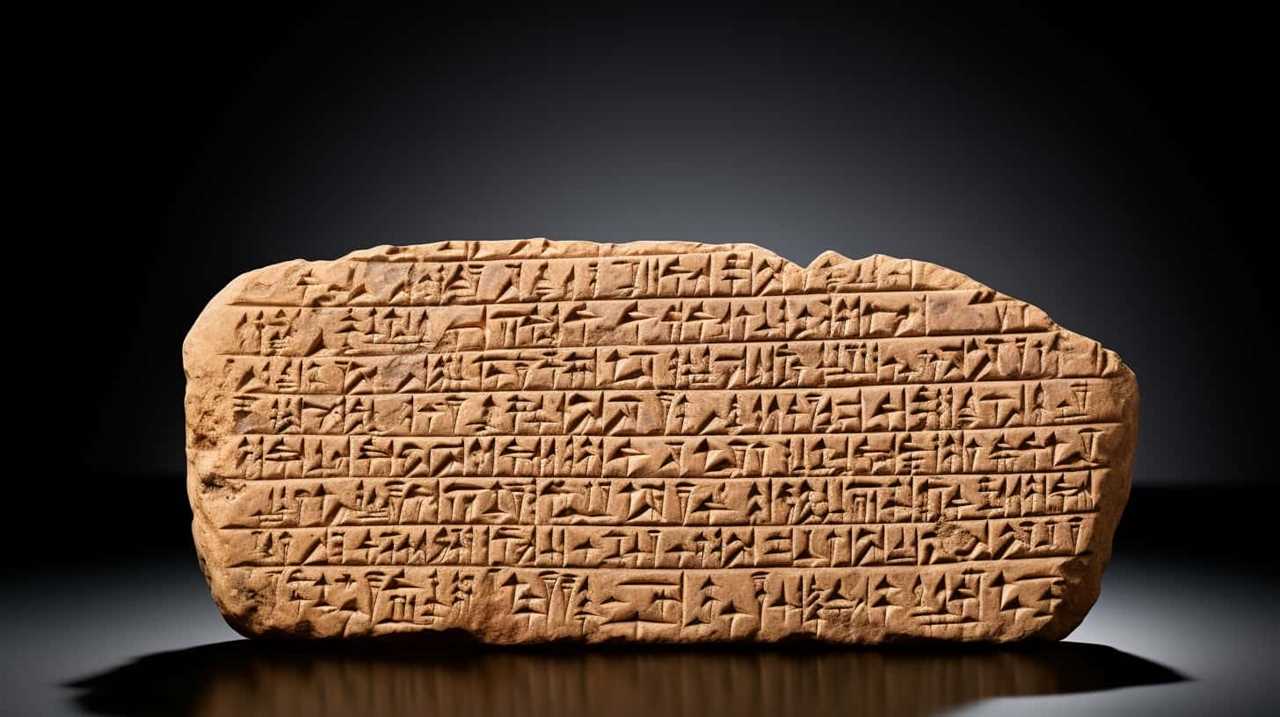
In the realm of leadership strategies, it’s crucial to grasp the intricacies of influence and authority. Sources of power can be categorized into two main types: formal and informal.
Formal power derives from an individual’s position or role within an organization, such as a manager or a CEO. This type of power is based on authority and the ability to make decisions and allocate resources.
Informal power, on the other hand, is derived from personal qualities and relationships, such as expertise, charisma, and the ability to build strong networks.
Effective leadership requires balancing authority and influence, recognizing the importance of both formal and informal power sources. By understanding and harnessing these sources of power, leaders can effectively guide and inspire their teams towards success.

Balancing Authority and Influence
In our exploration of leadership and power, we find ourselves at the crossroads of balancing authority and influence. Balancing authority involves recognizing and utilizing one’s position of power, while influence encompasses the ability to persuade and inspire others. Navigating power dynamics requires a delicate understanding of how to wield authority without abusing it and how to leverage influence without manipulating others.
In the realm of leadership, spirituality can play a significant role in achieving this balance. By grounding oneself in values, principles, and a sense of purpose, one can lead with authenticity and integrity.
Here are four key considerations for balancing authority and influence in leadership:
- Self-awareness: Understanding one’s own strengths, weaknesses, and biases is essential for effective leadership.
- Active listening: Listening attentively and empathetically allows leaders to understand the perspectives and needs of their team members.
- Collaboration: Encouraging collaboration and fostering a sense of shared ownership empowers individuals and strengthens the collective.
- Ethical decision-making: Making decisions based on moral principles and considering the long-term consequences ensures ethical leadership.
Uncovering the Secrets of Ancient Egyptian Magic
Exploring the fascinating realm of ancient Egyptian magic reveals a wealth of hidden knowledge and mystical practices. The Egyptians believed in the power of magic and its ability to influence the gods and bring about desired outcomes. Egyptian magical spells were often written down in spellbooks, which were carefully guarded and passed down through generations. These spellbooks contained a wide range of spells for various purposes, such as protection, healing, and love.

To give you a glimpse into the world of ancient Egyptian magic, here is a table showcasing some of the most commonly used magical spells:
| Spell Name | Purpose |
|---|---|
| "Spell for Protection" | To ward off evil spirits and protect against harm |
| "Spell for Healing" | To cure illnesses and promote well-being |
| "Spell for Love" | To attract love and strengthen relationships |
| "Spell for Prosperity" | To bring wealth and abundance |
| "Spell for Divination" | To gain insight into the future |
These spells were often accompanied by rituals, incantations, and the use of specific objects or symbols. The ancient Egyptians believed that by correctly performing these rituals and reciting the spells, they could tap into the supernatural forces and achieve their desired outcomes.
Studying ancient Egyptian magic provides us with a unique window into the beliefs and practices of this ancient civilization. It allows us to understand their worldview and provides valuable insights into their culture and religious practices.
The Importance of Balance in Hieroglyphics
One of the key aspects in deciphering Egyptian hieroglyphics is understanding the significance of balance within the symbols. The ancient Egyptians believed in the concept of duality, that everything in the universe is composed of complementary opposites. This belief is reflected in their hieroglyphics, where balance is a fundamental principle.

Here are four reasons why balance is important in hieroglyphics:
- Symbolic representation: Hieroglyphics often depict objects or concepts that have an inherent duality, such as the sun and the moon, or life and death. By maintaining balance in the symbols, the Egyptians were able to convey the dual nature of these concepts.
- Aesthetic appeal: Balance in hieroglyphics creates a sense of visual harmony. The symmetrical arrangement of elements within a symbol pleases the eye and adds to the overall beauty of the script.
- Cultural significance: Balance was highly valued in ancient Egyptian society, as it represented order, stability, and harmony. By incorporating balance into their hieroglyphics, the Egyptians were able to convey these cultural values.
- Decoding accuracy: Understanding the balance within hieroglyphics is crucial for accurate decipherment. By recognizing the balanced arrangement of symbols, scholars can gain insights into the meaning and purpose behind the ancient texts.
Discovering the Path to Enlightenment
Let’s embark on a journey of enlightenment as we unravel the mysteries of ancient Egyptian hieroglyphics. The ancient Egyptians believed that the path to happiness and spiritual enlightenment was a lifelong pursuit. They sought to understand the intricacies of the universe and the depths of the human soul. Through their hieroglyphic writings, they left behind a roadmap for those who seek the same enlightenment today.
To aid in our understanding, let us examine a table that highlights key concepts and symbols associated with the path to enlightenment in Egyptian hieroglyphics:
| Concept | Hieroglyphic Symbol | Meaning |
|---|---|---|
| Knowledge | Sesheta | The goddess of writing and record keeping |
| Wisdom | Thoth | The god of knowledge and wisdom |
| Meditation | Djed | Symbol of stability and spiritual strength |
| Inner Peace | Ankh | Symbol of life and eternal existence |
These symbols represent fundamental aspects of the path to enlightenment. The pursuit of knowledge, guided by the goddess Sesheta, leads to wisdom, embodied by the god Thoth. Through meditation, symbolized by the Djed, and finding inner peace, represented by the Ankh, one can attain spiritual enlightenment and ultimate happiness.
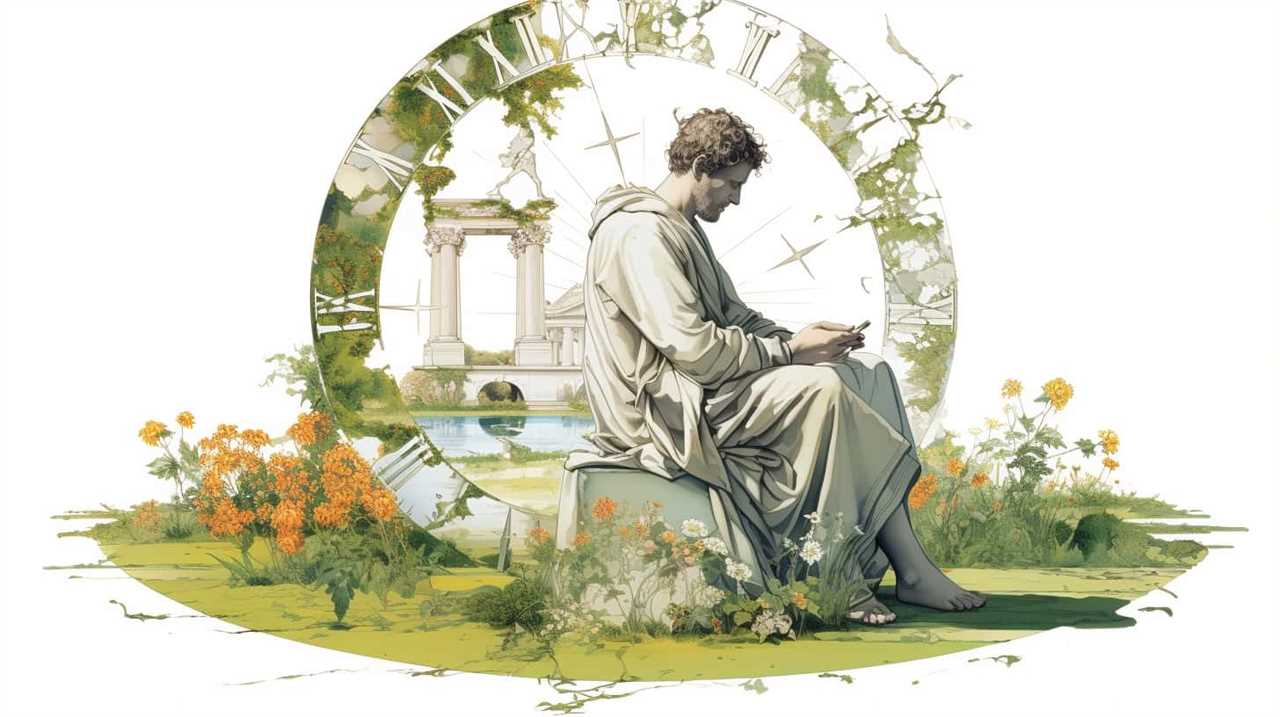
Ancient Egyptian Sayings on Health and Well-being
Ancient Egyptians valued health and well-being, as evidenced by their profound sayings. The ancient civilization had a deep understanding of the connection between diet, nutrition, and overall health. They believed that what one consumed played a vital role in maintaining good health and preventing diseases.
Here are some ancient Egyptian sayings on health and well-being:
- ‘Let food be thy medicine.’ This saying highlights the belief that a healthy diet is crucial for maintaining good health and preventing ailments. Egyptians believed that the right food choices could act as a form of medicine.
- ‘A balanced diet brings balance to life.’ This saying emphasizes the importance of a well-rounded diet that includes a variety of foods from different food groups. Egyptians believed that a balanced diet would promote overall well-being and harmony.
- ‘Healing lies in nature’s remedies.’ Egyptians relied on natural remedies for common ailments. They believed that plants and herbs possessed healing properties and utilized them in their medical practices.
- ‘The body is a temple, treat it with care.’ This saying reflects the belief that the body is sacred and should be taken care of. Egyptians understood the importance of maintaining physical health through proper nutrition, exercise, and hygiene.
Ancient Egyptians’ beliefs on diet and nutrition and their use of ancient remedies for common ailments highlight their holistic approach to health and well-being.
Unveiling the Mysteries of the Afterlife
Now, let’s delve into the fascinating realm of the afterlife, uncovering the secrets hidden within ancient Egyptian hieroglyphics. The mysteries of the underworld and the journey of the soul are central themes in Egyptian mythology and religious beliefs. Through the decipherment of hieroglyphics, we’ve gained insight into the profound beliefs and rituals surrounding death and the afterlife.

The ancient Egyptians believed that death was merely a transition to another realm of existence. They believed that the soul, or ka, would embark on a journey to the afterlife, guided by various deities and protective spells. Hieroglyphics provide us with detailed instructions and rituals to ensure a successful journey to the afterlife.
One of the most iconic symbols associated with the afterlife is the Ankh, which represents eternal life. This symbol can be found in countless inscriptions and tomb decorations, reminding us of the Egyptians’ strong belief in the continuation of life beyond death.
Another important aspect of the afterlife is the judgment of the soul. The Book of the Dead, a collection of spells and rituals, describes the judgment process in detail. The soul would undergo a series of tests and trials in the Hall of Ma’at before being granted access to the eternal paradise known as the Field of Reeds.
Through the decipherment of hieroglyphics, we’re able to unravel the mysteries of the afterlife and gain a deeper understanding of the ancient Egyptian beliefs surrounding death and the journey of the soul. These ancient writings provide us with valuable insights into the spiritual and religious practices of this remarkable civilization.

Lessons on Time and Mortality in Hieroglyphics
We uncover valuable lessons on time and mortality as we decipher the hieroglyphics of ancient Egypt. These ancient symbols provide deeper insights into the human understanding of acceptance, forgiveness, eternity, and immortality.
Here are four significant lessons we can learn from the hieroglyphics:
- Acceptance and Forgiveness: The hieroglyphic texts emphasize the importance of acceptance and forgiveness in one’s journey through life and beyond. It teaches us that holding onto grudges and resentments only hinders our personal growth and spiritual development.
- Concept of Eternity: Hieroglyphics reveal the Egyptians’ belief in the concept of eternity, where life continues beyond death. They believed in an afterlife where the soul would endure forever. This understanding of eternity reminds us to consider our actions and choices in the context of their long-lasting consequences.
- Immortality of the Soul: The hieroglyphics also shed light on the Egyptians’ belief in the immortality of the soul. They viewed death as a transition rather than an end, with the soul continuing its existence in the afterlife. This teaches us to reflect on our own mortality and strive to leave a lasting legacy.
- Appreciation of the Present Moment: Hieroglyphics remind us of the fleeting nature of time and the importance of cherishing each moment. They encourage us to live fully in the present, appreciating the beauty of life while we’ve the chance.
Frequently Asked Questions
How Were Hieroglyphics Used in Everyday Communication in Ancient Egypt?
In ancient Egyptian society, hieroglyphics were extensively used for everyday communication. They served as a symbolic language, conveying a wide range of meanings and ideas. The intricate system of hieroglyphics reflected the complexity and depth of their culture.
What Materials Were Commonly Used to Create Hieroglyphic Inscriptions?
Papyrus scrolls and stone carvings were commonly used materials to create hieroglyphic inscriptions. These materials allowed for the preservation of ancient Egyptian knowledge and served as a medium for communication across generations.

Can Hieroglyphics Be Translated Into Other Languages?
Yes, hieroglyphics can be translated into other languages. However, the process is complex and presents unique challenges due to the intricacies of hieroglyphic script and the cultural significance of translation in ancient Egypt.
How Did Hieroglyphics Evolve Over Time?
Evolutionary changes in hieroglyphic script development occurred over time. The script initially consisted of pictorial symbols representing objects, which then evolved into a more abstract form, incorporating phonetic elements to represent sounds and words.
Are There Any Hieroglyphic Symbols That Are Still Not Fully Understood by Scholars?
Unraveling mysteries in hieroglyphics, scholars have yet to fully understand some symbols. These untranslated symbols present a challenge to our mastery of ancient Egyptian language and culture. Further research is needed to unlock their secrets.
What is the significance of Egyptian Hieroglyphics in understanding ancient sayings and text?
Egyptian hieroglyphics are key to unraveling ancient texts and sayings. The intricate symbols provide a window into the thoughts and beliefs of the past, much like unforgettable villain monologues reveal the inner workings of characters. Both offer valuable insights into long-gone cultures and societies.
Conclusion
In conclusion, deciphering Egyptian hieroglyphics allows us to uncover the timeless wisdom and insights of the ancient Egyptians. From the meaning of life and love, to the secrets of success and enlightenment, their proverbs and sayings offer valuable lessons that resonate even in the modern world.

By delving into these ancient texts, we embark on a journey through time, unraveling the mysteries of an extraordinary civilization and gaining a deeper understanding of the human experience. In this pursuit of knowledge, we unlock the doors to our own enlightenment.
Lauren’s talent in writing is matched by her passion for storytelling. Her love for books and deep understanding of culture and entertainment add a distinct flavor to her work. As our media and press contact, Lauren skillfully bridges the gap between afterQuotes and the broader media landscape, bringing our message to a wider audience.
